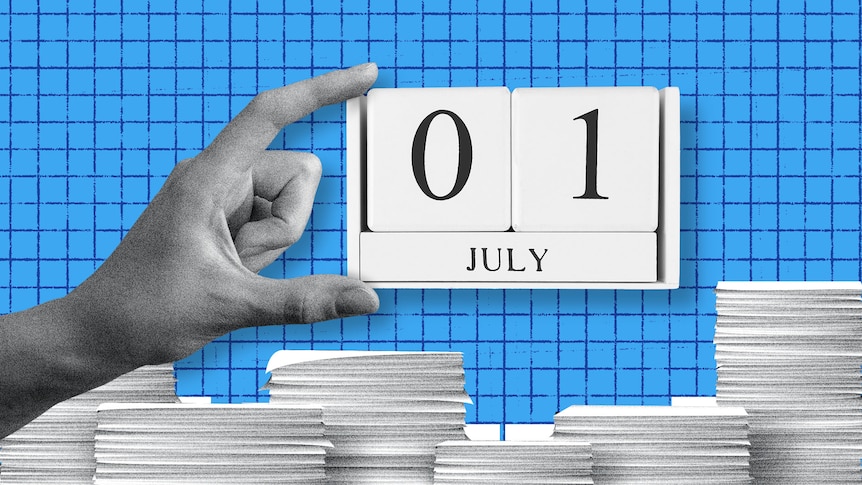The new financial year is here and with it comes new laws, rules and payments that will effect Australian families and businesses.
Here’s a breakdown of all the changes coming your way from July 1.
Changes to road rules
There are several changes to Australian road rules that will come into effect on the first day of July.
Nationally, AI-powered surveillance cameras will be rolled out across the country to detect use of phones while driving.
There will also be new speed limits for many states in response to increased road deaths.
In Queensland, there will be a 3.4 per cent increase in car registration and fines.
In New South Wales, drivers will face higher penalties if they fail to wear a seatbelt.
In Victoria, drivers will be required to slow down to 40 kilometres per hour when approaching or passing by a slow-moving (less than 10 kilometres an hour) or stationary police, emergency or escort vehicle.
Failure to comply will result in a maximum fine of $961.
In Western Australia, speed limits on several roads will be significantly reduced in response to the state’s road toll.
You can see what roads here.
South Australian drivers will be forced to slow down to 25kph when passing breakdown recovery vehicles.
Failure to slow down could result in fines of up to $1,648.
Minimum wage increase
From the first of July, the minimum wage will go up by 3.5 per cent.
Millions of Australian workers will get a 3.5 per cent pay rise from July 1, following the Fair Work Commission’s (FWC) annual review of the minimum wage and award agreements.
The commission’s decision increases the national minimum wage to $24.95 per hour or $948 per week, based on a full-time, 38-hour working week.
Paid parental leave
The amount of parental leave pay available to families will increase to 120 days (24 weeks) for children born or adopted from July 1, 2025.
This will increase to 24 weeks for children born or adopted after July 1 next year, and to 26 weeks in 2026.
It’s estimated about 180,000 families receive the support each year.
The following will also increase:
the number of days reserved for your partnerthe number of days you can take at the same time as another parent
The number of days you get is based on the date your child is born or comes into your care.
If you submit a pre-birth claim before July, your parental leave pay days balance will be 110 days.
If your child is adopted from July 1 2025, the government will add an extra 10 days once it receives document proof of the adoption or birth.
Superannuation changes
There are a couple of changes coming for superannuation on July 1.
The guarantee rate which is the percentage of a salary an employer must pay to their employees’ superannuation account — will increase from 11.5 to 12 per cent.
The minimum SG rate employers must pay for each eligible employee from July 1, 2024 is 11.5 per cent of their ordinary time earnings (OTE).
This is scheduled to progressively increase to 12 per cent on July 1, 2025.
Power price increases
In three states, power prices are set to go up.
The Australian Energy Regulator (AER) will raise power prices for many people in New South Wales, South Australia and South East Queensland.
It announced what’s called a Default Market Offer for the next financial year.
Changes in pricing will depend on where you live and you can check what that will be here.
It will depend on which state you’re in, which power company you go with and what plan you’re on.
So we can’t give a definitive answer on that — but, by looking at the DMO figures, we can give you a general idea for the three states covered by the AER.
For more information, click here.
Pension increases
From July, the rate of the age pension for asset-tested couples will increase by $34.50 a fortnight, and $22.50 a fortnight for singles.
NDIS price changes
The National Disability Insurance Agency (NDIA) will introduce changes to NDIS pricing from July 1, 2025 designed to ensure NDIS participants are charged in line with other Australians receiving these supports through Medicare or Private Health Insurance.
Each year, the agency said it undertakes an annual pricing review (APR) to ensure the market is delivering sustainable and high-quality supports for NDIS participants.
As a result of the review there will be cuts to allied health services as well as a reduction of claimable travel time by 50 per cent.
There has been criticism by advocacy groups who say it will make access to services more difficult in rural areas.
NDIS pricing changes from July 1, 2025
Travel claims halved: Therapists can now only bill 50 per cent of their hourly rate for travel time.Therapy rates frozen: No CPI indexation for most allied health services this year. Physiotherapy: Rate drops by $10/hr, from $193.99 to $183.99 nationally. In WA, SA, NT and Tasmania, where regional loadings are removed, the cut exceeds $40/hr.Podiatry and dietetics: Rates drop by $5/hr, from $193.99 to $188.99 nationwide.Psychology: Only increase — rising $10/hr to $232.99 nationally. But in regions losing loadings, some may still earn less overall.
